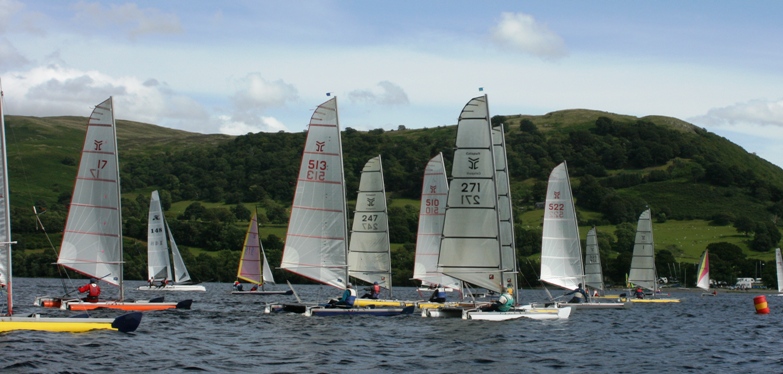
tactics at the start
Home Page
Tactics and Rules
CATAPULT TACTICS AT GRAFHAM: starting in a mixed fleet in
fresh winds. The line is well-laid at right angles to the wind, so there are
different starboard-start options for the Catapults.
 |
Paul and Alastair (503 and 513) are using conventional tactics,
easing along slowly to pass close to the Committee boat. This keeps the advantage of a safe position (with starboard rights over the fleet) and they will be close to the line on the gun. Disadvantages: they may be barged by boats not behaving, and in a larger fleet this can throw the whole start out, with boats coming through to windward (see Race 5 at Rutland 2010) Moving slowly in the disturbed air of larger fleet risks stalling (and this happened to them both in Race 2 at Grafham) and accelerating away may be slowed. |
Gareth (91) is using a high-speed start, staying
a long way back, and above the close-hauled line, coming down fast to
the gun. The advantage is starting at speed, and usually having a clear
run in. Boats trying a slow-speed start (503 and 513) may sag down
enough to leave a gap at the Committee boat, but in any case Gareth
should be able to follow them and then use speed to climb a bit to
windward over them.
Disadvantage: a high-speed start is harder to time, and one or
two boats at least will usually start ahead. In a bigger fleet (20-odd)
there may be no gap to fly through, in a procession at the Committee
boat
Cliff (17) is electing to go down to the middle of the line, where he is
safely free of other boats and able to come near the line and then
approach at speed, below close-hauled. He points lower for speed a short
time after the start, to clear his air of any boats to windward. The
advantage is sailing his own race confident of boat speed.
Disadvantages: it is essential to time the start accurately, and in
a mixed fleet somewhat faster boats may still come past to windward
(e.g. the Shearwaters at Grafham). Eventually he may have to cross the
fleet on port (unless he goes on out to the far left side of the course,
and waits until everyone else has tacked across.)
Click for: Tactics and
Rules:Index
Tactics and Rules:Introduction
What not to do at the start
A START AT BALA 2008
A big Catapult start in light winds (at the 25th
Anniversary Bala Gala in 2008) The shore-based start has a slight
starboard bias, so the shore end gives some distance advantage, and
everyone is starting on starboard.
1: Before the start.
 |
Around 30 seconds from the start 271 (white
hulls) seems to have the best place, heading to pass just inside the
mark.
513 and 17 have contested
the starboard end, but have finished up in poor positions
blanketed by 271 and an obscured boat.
As there are clearly some seconds to go, they may be best
bearing away (if they can avoid boats below them) to cross at
speed further down the line.
Several boats have been
content to approach the line further down, and Nigel in 522 looks
settled and concentrating on his own race.
Further away, Alex in the distant yellow-hulled Catapult 1 on the right
is hovering near the line, pointing further up into the wind.
Yellow hulls coming in
from the left (518, obscured) appears to have left it too late, but also
has the problem (if he gets there in time) that 271 will not need to
give him any room at the mark. Following 271 across going quickly may be
a good option still.
2:
The start

522 has got away well and Alex in 1 is turning and hauling in to
accelerate away. They each have space, so can concentrate on boat speed.
271 is no longer in
control, as boats below him have tightened up to the line, and
Paul in 307 has had enough clear breeze to come up to the line
on a close-hauled course to take the pole position, so that 271
has had to hang back.
This demonstrates that at the start, boats
below you are more of a threat to your plans than boats to windward (if
all are obeying the rules, see "The
Start: barging")
513 and 17 (orange hulls, now
obscured) have made little progress, showing that in light
winds, being stuck in a pack will take a long time to disentangle, so
that contesting the obvious favourite spot has to succeed, or be
replaced by a cautious alternative.
As predicted, 518 is late, and again in light winds this costs, whereas
the same position in fresher breeze would be still useful, able to
speed to the line. He is well above the close-hauled course, so can run
down to follow 271 across, probably able to ride over 513 and 17 (but he
has no right to room at the mark, as he is coming in heading below the
"Proper Course", so he must think ahead, and avoid rushing
down fast and crashing into the sterns of the boats going more slowly
over the line. )
Click for:
Back
to topTactics and Rules
The Start
The port end start